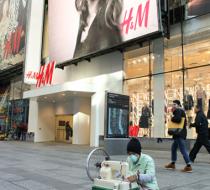</3 Less than Three and Up Srei: Art and the Cambodian Worker Struggle 1 Favorite
On a freezing Friday in January, Khmer-American artist Kat Eng sits in front of retail giant H&M’s Time Square store working on a manual sewing machine. For eight hours, Eng stitches together U.S. dollar bills while wearing a surgical mask and bloodstained shirt. Her performance “</3 Less Than Three” protests the way fast fashion and consumer culture creates oppressive conditions for Khmer workers.
Earlier in January, the Asia Pacific Forum on Women, Law, and Development (APWLF) called for a Global Week of Action against the Government Crackdown on Cambodian Protesters to create international solidarity in response to the brutal military police crackdown that killed 5 and injured dozens more striking garment workers in Cambodia. 500,000 workers joined a strike demanding livable wage, shutting down 400 factories until the government ordered police to fire on demonstrators. The current daily salary for workers is $2.66. During the performance, the artist stitched together 2 and 2/3 actual dollar bills symbolizing the appalling average wage.
Cambodia’s largest export earner is the textile industry, which brought in $5 million in 2013. The money supports profitable corporations such as H&M, Gap, and Walmart, which provides cheap clothing to consumers, but the factory workers continue to live in poverty. The strike shut down 400 factories, and then the government ordered the police to fire upon demonstrators, using violence to enforce silence.
“There are no easy solutions, but the first step is to engage with the grim reality: our constant demand for new cheap clothes has an unaffordable human cost,” writes Eng. “It is time for us to examine our priorities as American consumers. We know our clothes are made in sweatshops on the other side of the world. So is there anything we can do about it? Despite international protests, demonstrations, petitions, and boycotts, the industrial machine grinds on. The scale of the problem can seem overwhelming.”
Eng calls on others to create an open and collaborative space for unpacking the Khmer-American experience. Her upcoming creative dissent project, Up Srei, chooses the route of direct action and engagement by using people-powered media that focuses on Khmer women, workers, and activists through a feminist and anti-capitalist lens.
Eng writes: “The campaign is not for pity or charity. It is an act of solidarity with the women who labor under the boot of multinational corporations and their collapsing industrial machines, women who literally create immense value with their own callused hands yet remain in poverty. It is a message to consumer culture: behind every stitch is a hand, a face, a person. It is a critique of working class commodification and the brand industrial complex. I am not here to list the names of every corporation engaged in exploitation in Cambodia- though I will. I am here to meet you, the consumer, and to be consumed by you and to rest in the pit of your stomach. To be explicit, to haunt you while you shop.”
Brooklyn-based artist Kat Eng is a cold-weather multi-media artist and activist working on becoming a “regular propaganda machine”.









